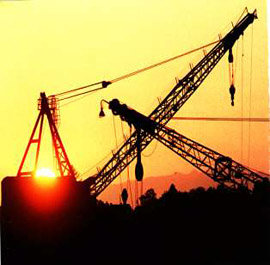
|
| |

|  Romania Romania
the awakening giant of Europe |

 Looking for lost prosperity - 1997 : A mixed performance - Rebuilding the Country - Looking for lost prosperity - 1997 : A mixed performance - Rebuilding the Country -
Major Infrastructure Projects March On - The Tough Game - No Pain, No Gain -
The Young Wolves of the Private Sector - What's Next? 
 The Tough Game The Tough Game
There is little doubt that the top priority of the government in 1997 was the privatization. As in most the other areas of the economic reform, the results of state’s divestment process have showed both lights and shadows. The data released by the SOF , Romania’s main privatization body, prove that, although much more was done in this respect than during the past years, the pace of privatization was far from reaching the initial target, of 50 companies per week. 1,304 companies have been sold over the year
– out of which only 50 large companies and 170 medium-sized (according to the Romanian standards, a large company has an equity in excess of Lei20 billion, some $2.5 million, while the equity capital of a medium-sized company ranges from Lei2 billion to Lei20 billion). Most of these companies (1,064) have been sold through direct negotiations, while 231 were auctioned; the rest were floated on the capital markets.

The overall divested capital reached Lei2,166 billion; only 1995, with Lei1,840 came closer to the 1997 figure. As compared with the previous years, the sector structure of the privatized companies changed significantly, with many companies within heavy industry (supposedly less interesting to the investment community than trade or tourism, for instance) becoming private. Several industrial sectors, as textiles and confections are virtually entirely private. Other areas, as packaging, plasticware processing and building materials are privatized 80-90 percent. The cement industry – the hot spot of 1997 privatization – passed 80 percent in private hands. However, probably the point where the new privatization policy has made the most of a difference, was in attracting foreign capital in the process. While in 1995 and
1996 the Romanian privatization process lured tiny foreign capital (worth $15.8 and $17.3 million, respectively), last year this amount skyrocketed to $515.2 million. Over half of this amount ($261 million) was due to several spectacular deals within the cement industry. Three of Romania’s six cement producers were taken over by foreign investors; the selloff of Romcim (a company that largely accounts for half of Romania’s cement industry) to the French Lafarge for some $200 million, was the largest ever privatization deal closed in Romania. Metallurgical industry (with $82.7 million) and machinery & equipment industry ($68.7) came as distant second and third.
Another policy change regarded the investment projects of the new owners. The investments committed by the new owners of the companies privatized in 1997 amount to Lei1,031 billion and $463.5 million – as compared with Lei740.8 billion and $101 million a year before. "The previous management of the SOF put a great emphasis on the price obtained for state’s share in the company. We are focused more on the investment volume committed in the company by the new owners, because Romania’s greatest interest is to have an efficient economic structure. A new strategy of privatization is a sense of direction – where do we want to go, what kind of economic system do we want to build, what do we intend to develop. Therefore, there are not the revenues that are important in the privatization process – and this is a principle which has been included in the new law of privatization. The important thing is to develop the company, to create a new economic system – a capitalist one – which will afterwards create resources without state’s intervention. By privatizing state’s possessions we are not looking only for small, short-term effects, but also to put Romania in a global system.
The rush has its own drawbacks, and some 200 privatization contracts have been cancelled, including one that would have been the largest ever – the almost half billion USD deal regarding the takeover of Romania’s most modern oil refinery (Petromidia, some
10km North of Constanta , on the Black Sea coast) by a specially assembled US-Kuwait consortium, Petromidia USA. The refinery is back on sale. This rush is fully understandable, by postponing privatization there will be more and more difficult, even impossible to privatize certain companies, because they become less and less attractive. The recent privatization story of IMGB – once a pride of the Romanian heavy machinery & equipment industry – was an example. Although the company operates pretty modern technology, it failed to adapt to the realities of a market economy and, year after year, it accumulated a huge debt. Finally it was sold almost for nothing -- $0.5 million!!! -- to the Norwegian Kvaerner, who will also pay IMGB’s debts, in excess of $30 million. There is no special protection for the Romanian investors; there are exactly the same terms and conditions for any investor attending privatization, regardless of nationality, origin and so on.
The plans for this year are even more ambitious. Despite it would put on the sales block some 2,700 companies with an equity capital of Lei30 trillion (almost $4 billion), the SOF realistically looks forward to privatize some 1,600 companies with an equity of about Lei10 trillion. If done, it would mean more than it was privatized during the eight years of transition that passed so far. Besides Romtelecom – which should account for some half of these money, Romania will finally turn private at least two state-owned banks. The process (that the international financial institutions had been calling for years) began in 1997, but the outcome will only be seen this year.
The first bank to go public will be a small one, BancPost, followed by the larger Romanian Development Bank (BRD). Two consortia led by major foreign banks – ABN Amro and Daiwa Europe – are advising the state in the process. | 
A third bank, Banca Agricola – Romania’s largest bank in terms of accounts and customers, dealing primarily with customers within the agribusiness and food processing industry
– currently undergoes a massive restructuring program and it will likely be privatized by the end of 1998 or early next year. Mr. Silviu Istrate , the Chairman of the bank, underlines the main features of the restructuring plan: "First of all, our balance sheet losses – generated by the fact that until 1996 the prices of food were held at low levels by means of subsidized interest loans our bank was forced to grant to producers – were cut down. The state financed them by issuing T-bills worth about $500 million. Then we started to operate on a real base, planning to become a retail bank able to offer customers the whole range of banking products and services. In this respect, we have the advantage of already keeping
40 percent of the Romanian people savings, and the largest network in the country –
306 units. Another, less pleasant part of the restructuring plan, was the layoff. We used to have some 11,500 employees; only 8,500 will finally stay. I do believe we’re on the right track – everyone expected us to show big losses last year, but we managed to register Lei161 billion gross profit."
As for the Romanian Commercial Bank (BCR) , one of the top three largest Romanian state-owned banks, its privatization is not seen as a emergency. The bank was born in 1990, when the central bank spun off its commercial operations into a new entity, BCR. "It was actually the beginning of banking system’s reform in Romania," says Mr. Ion Ghica, BCR’s Chairman. A man who spent his entire active life – 38 years so far – in the banking industry, Ghica built BCR from scratch. Besides the customer base and operations – "95 percent of the balance sheet was made of short term loans granted to Romanian companies," adds Ghica -- BCR also inherited from the central bank a healthy behavior, more conservative and risk adverse, which prevented BCR from getting involved into troubles and scandals. BCR pioneered many new fields for the Romanian banking system. "We were the first Romanian bank to raise funds from the international capital markets, by means of a $75 million corporate bonds issue; we also were the first to build a special division for capital markets operations, dealing both home and abroad.

We were the first to introduce ATMs in this country, and we are leaders in the credit card business. We even made it into The Banker’s top 25 most profitable banks, with an estimate 1997 profit/capital ratio of 60.1 percent," concludes BCR’s Chairman. The bank focuses on corporate finance – 80 percent of the Romanian industry works through BCR – but also intends to develop its retail banking business. Meanwhile, it developed a special relationship with Citibank, American Express and USA’s EximBank.
Mr. Camenco Petrovici , the President of the Romanian Savings Bank (CEC) , believes that in the future his bank will put a bigger print on the Romanian banking system: "In 1997 we ranked third in terms of assets. We have over 2,100 branches around the country – all the other commercial banks together have 1,200. We will greatly expand our scope of activities: besides the savings accounts, we intend to open current accounts for individuals and companies, to give loans to the population for house building and home improvement, to begin lending to SMEs and to the public administration, both central and local, to participate with capital in companies with sound prospects, and generally to become more active. Last year we became VISA and EUROPAY members. We are developing business relations with Bank of America, which is interested in housing projects and road infrastructure. These are, as a matter of fact, two of our top three priorities – the other being SME development." |
© World INvestment NEws, 1998.
This is the electronic edition of the special country report on Romania
published in FORBES
Magazine's enriched with complementary information,
such as full interviews, detailed company files and more.
June 1 st 1998 issue
Developed by AgenciaE.Tv |
|
|
|
| |
| | | |
|

